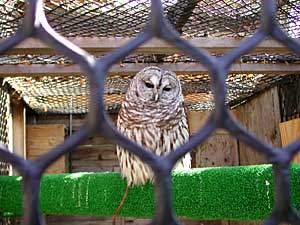|
Audio
Photos
Resources
|
March 17, 2005
St. Paul, Minn. — A rodent shortage in Canada is forcing thousands of northern owls, great gray owls, and northern hawk owls into Minnesota in search of food. The biggest of the bunch -- great grays -- have been spotted as far south as Iowa.
The phenomenon is called an owl invasion, and it's caused a dramatic increase in the number of injured birds being treated at the University of Minnesota Raptor Center.
Owl invasions occur every seven to 12 years, when the numbers of the owls' prey (voles, lemmings, and other small rodents) decline in their normal winter habitat in Canada and northern Minnesota. That means the owls travel south from their usual habitat in search of food.
Normally the center treats one to three great gray owls a year. So far this winter, they've seen 90 -- including three new admissions Tuesday alone.
Dr. Julia Ponder, associate director of the Raptor Center, says the owls' main enemy is cars.
"(Owls) are hunting rodents, which are typically easily found along fields, along roadsides. And they just seem totally oblivious to cars," Ponder says.
Dr. Ponder estimates the owl influx will cost the center $30,000 this year.
"There is no way to budget for an event like the owl invasion," says Ponder, who says it costs about $1,000 to rehabilitate and release each owl.
The Raptor Center has received a grant of up to $20,000 from the Katherine A. Andersen Fund of The St. Paul Foundation to help pay the extra cost of caring for the owls. It's a matching grant, meaning that every dollar given to the The Raptor Center for the care of the owls will be matched by the foundation.
The owls' mating season is next month, and the staff hopes to release the owls back to their natural habitat by that time.
MPR's Steven John visited the Raptor Center and spoke with Dr. Ponder. To listen to their interview, choose the audio link in the right column.






